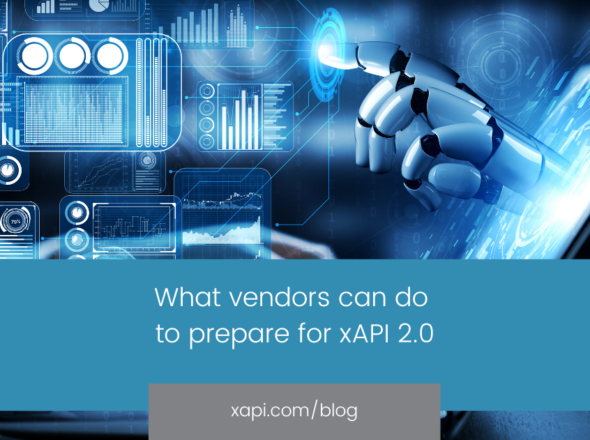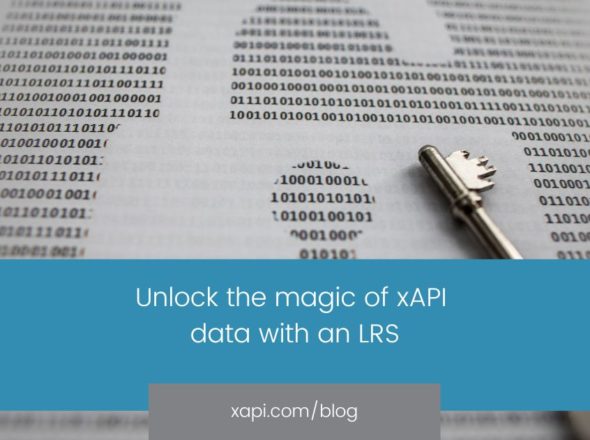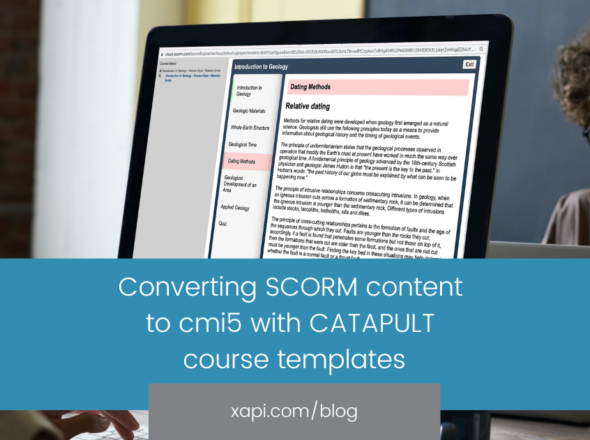On 9/11/14, we hosted a webinar for the Columbus chapter of ATD, and as usual, the attendees had more questions that we could answer during the live webinar, so we’ve posted the questions and the answers here.
Q: With which SCORM versions is Experience API compliant?
A: None of them. xAPI is a completely new standard. You can use xAPI to do many of the same things you could do with SCORM, but the technical implementation behind the scenes is very different. The question is akin to asking “is streaming video compatible with VHS or Betamax?”. They are very different technologies, but any movie you watched on video tape can also be watched on streaming video and streaming video allows you to do much, much more.
Q: What LMS accept the Experience API?
A: Check out the adopters page here, and click on the LMS filter to see: ../adopters/. More and more are adopting every day. Vendors have taken very different approaches to adoption. Some do the bare minimum to simply replace SCORM with xAPI for tracking formal e-learning courses. Others are fully embracing the power and functionality of xAPI. There are drastic differences and hard problems for LMS vendors to solve. If you want to take a deep dive into the different considerations and options for LMS vendors considering xAPI, check out our xAPI Impacts whitepaper.
Q: I get the impression that numerous organizations are developing LRS systems. Are you aware of any new content delivery systems that are designed to be compliant with xAPI?
A: Yes, I think, it depends on what you mean by “content delivery systems”. Take a look at the xAPI Adopters page and you will see many tools that either produce or deliver content. If by “content delivery systems”, you are referring to the conceptual “Training Delivery System (TDS)” that was mentioned in the presentation, then, no, there aren’t a lot of pure TDSs out there yet. Our SCORM Cloud product comes close to being a TDS. Others use basic LMSs to fill that role as well.
Q: Articulate uses xAPI? How? I don’t see anything beyond SCORM in that publishing tool.
A: Articulate Storyline was a very early adopter of xAPI to enable tracking from their iPad app (how to publish to xAPI). I believe the latest version of Presenter will also allow you to publish to xAPI.
Q: So there should be a publish as xAPI in our content creation tools? What about Adobe and MS Office? Are they included yet?
A: Ideally, yes. At a minimum I expect all content creation tools that are specifically in the learning space to have a “Publish to xAPI” feature in an upcoming release. I would love to see that functionality bleed over into non-learning specific tools as well, but if that does happen it will probably be several years from now.
Q: What is needed to set-up an LRS?
A: There are several commercial and open source LRSs that are easily setup and ready for use. See the xAPI Adopters page for a complete list. Our SCORM Cloud product includes a completely free basic LRS product that you can start using just by signing up for an account. We’ve also published some information on what it takes to build a LRS if you’re feeling adventurous.
Q: One of the main issues about getting summary/aggregated reports out of the LMS is the challenge and complexity of the queries. Doesn’t xAPI make the complexity of writing queries for summary data much harder and therefore create more of a black hole? We currently use a BI tool to write reports against relational databases and tables in a datamart. What is the data structure of the LRS? Is an LRS just one massive table? If so, how do you join/connect the data so that the aggregated data queries are of decent performance. What are people using with the LRS? relational databases? SQL? I just can’t get my head around this…it seems to me report/analytics writing is going to be way more challenging and time consuming…I’d appreciate any feedback about this. Thanks.
Q: I keep thinking that the LRS is just an audit trail/log for a user. How do you write efficient queries against what is essentially a log file? Still confused…
A: Great questions. You are hitting on the hardest technical problem that xAPI presents. I view the solutions to these problems as the role of the LRS. The LRS should provide the tools that abstract the complexity of making sense of the xAPI data. There is no single best way for an LRS to do this and each of the early LRS vendors seems to be taking a different approach.
Q: Is “bookmarklet” a general term? Or used only and specifically within Watershed LRS?
A: It’s a general term for an application that resides inside a browser bookmark (http://en.wikipedia.org/wiki/Bookmarklet). We publish a xAPI bookmarklet that can be used with any LRS for free here: ../bookmarklet/.
Q: Can we see a demo of how the API actually works? Getting lots of info about it…how does it work?
A: There are tons of resources for how the API functions on our technical page for developers: ../page-developers/. Let us know if you want a deeper dive.
Q: I’M LOVING THIS STUFF!!!!!!!!!!
Q: This was great!
A: 🙂


